Photo-Elastic Enhanced Optomechanic One Dimensional Phoxonic Fishbone Nanobeam
Abstract
:1. Introduction
2. Materials and Methods
3. Results
3.1. Band Structures of Photonic Crystal and Phononic Crystal
3.2. Optical and Acoustic Resonance Modes
3.3. AO Coupling Rate Calculations
3.4. AO Coupling Rate Discussions
4. Conclusions
Author Contributions
Funding
Institutional Review Board Statement
Informed Consent Statement
Data Availability Statement
Conflicts of Interest
References
- O’Brien, J.L.; Furusawa, A.; Vučković, J. Photonic quantum technologies. Nat. Photonics 2009, 3, 687–695. [Google Scholar] [CrossRef] [Green Version]
- Zhang, W.; Cheng, K.; Wu, C.; Wang, Y.; Li, H.; Zhang, X. Implementing Quantum Search Algorithm with Metamaterials. Adv. Mater. 2018, 30, 1703986. [Google Scholar] [CrossRef] [PubMed] [Green Version]
- Rakhmanov, A.L.; Zagoskin, A.M.; Savel’ev, S.; Nori, F. Quantum metamaterials: Electromagnetic waves in a Josephson qubit line. Phys. Rev. B 2008, 77, 144507. [Google Scholar] [CrossRef] [Green Version]
- Stav, T.; Faerman, A.; Maguid, E.; Oren, D.; Kleiner, V.; Hasman, E.; Segev, M. Quantum entanglement of the spin and orbital angular momentum of photons using metamaterials. Science 2018, 361, 1101–1104. [Google Scholar] [CrossRef]
- Jin, Y.; Fernez, N.; Pennec, Y.; Bonello, B.; Moiseyenko, R.P.; Hémon, S.; Pan, Y.; Djafari-Rouhani, B. Tunable waveguide and cavity in a phononic crystal plate by controlling whispering-gallery modes in hollow pillars. Phys. Rev. B 2016, 93, 054109. [Google Scholar] [CrossRef] [Green Version]
- Mohammadi, S.; Eftekhar, A.A.; Hunt, W.D.; Adibi, A. High-Q micromechanical resonators in a two-dimensional phononic crystal slab. Appl. Phys. Lett. 2009, 94, 051906. [Google Scholar] [CrossRef]
- Notomi, M.; Tanabe, T.; Shinya, A.; Kuramochi, E.; Taniyama, H.; Mitsugi, S.; Morita, M. Nonlinear and adiabatic control of high-Q photonic crystal nanocavities. Opt. Express 2007, 15, 17458–17481. [Google Scholar] [CrossRef]
- Quan, Q.; Loncar, M. Deterministic design of wavelength scale, ultra-high Q photonic crystal nanobeam cavities. Opt. Express 2011, 19, 18529–18542. [Google Scholar] [CrossRef] [Green Version]
- Tomljenovic-Hanic, S.; Steel, M.J.; Sterke, C.M.d.; Moss, D.J. High-Q cavities in photosensitive photonic crystals. Opt. Letters 2007, 32, 542–544. [Google Scholar] [CrossRef]
- Eichenfield, M.; Chan, J.; Camacho, R.M.; Vahala, K.J.; Painter, O. Optomechanical crystals. Nature 2009, 462, 78–82. [Google Scholar] [CrossRef]
- Aboutalebi, S.Z.; Bahrami, A. Design of phoxonic filter using locally-resonant cavities. Phys. Scr. 2021, 96, 075704. [Google Scholar] [CrossRef]
- Amoudache, S.; Pennec, Y.; Djafari Rouhani, B.; Khater, A.; Lucklum, R.; Tigrine, R. Simultaneous sensing of light and sound velocities of fluids in a two-dimensional phoXonic crystal with defects. J. Appl. Phys. 2014, 115, 134503. [Google Scholar] [CrossRef]
- Jin, J.; Wang, X.; Zhan, L.; Hu, H. Strong quadratic acousto-optic coupling in 1D multilayer phoxonic crystal cavity. Nanotechnol. Rev. 2021, 10, 443–452. [Google Scholar] [CrossRef]
- Laude, V.; Beugnot, J.-C.; Benchabane, S.; Pennec, Y.; Djafari-Rouhani, B.; Papanikolaou, N.; Escalante, J.M.; Martinez, A. Simultaneous guidance of slow photons and slow acoustic phonons in silicon phoxonic crystal slabs. Opt. Express 2011, 19, 9690–9698. [Google Scholar] [CrossRef] [Green Version]
- Laude, V.; Beugnot, J.-C.; Benchabane, S.; Pennec, Y.; Djafari-Rouhani, B.; Papanikolaou, N.; Martinez, A. Design of waveguides in silicon phoxonic crystal slabs. In Proceedings of the 2010 IEEE International Ultrasonics Symposium, San Diego, CA, USA, 11–14 October 2010; pp. 527–530. [Google Scholar]
- Lin, T.-R.; Lin, C.-H.; Hsu, J.-C. Enhanced acousto-optic interaction in two-dimensional phoxonic crystals with a line defect. J. Appl. Phys. 2013, 113, 053508. [Google Scholar] [CrossRef]
- Ma, T.-X.; Wang, Y.-S.; Zhang, C. Photonic and phononic surface and edge modes in three-dimensional phoxonic crystals. Phys. Rev. B 2018, 97, 134302. [Google Scholar] [CrossRef]
- Ma, X.; Xiang, H.; Yang, X.; Xiang, J. Dual band gaps optimization for a two-dimensional phoxonic crystal. Phys. Lett. A 2021, 391, 127137. [Google Scholar] [CrossRef]
- Xia, B.; Fan, H.; Liu, T. Topologically protected edge states of phoxonic crystals. Int. J. Mech. Sci. 2019, 155, 197–205. [Google Scholar] [CrossRef]
- Zhang, R.; Sun, J. Design of Silicon Phoxonic Crystal Waveguides for Slow Light Enhanced Forward Stimulated Brillouin Scattering. J. Lightwave Technol. 2017, 35, 2917–2925. [Google Scholar] [CrossRef]
- Chiu, C.C.; Chen, W.M.; Sung, K.W.; Hsiao, F.L. High-efficiency acousto-optic coupling in phoxonic resonator based on silicon fishbone nanobeam cavity. Opt. Express 2017, 25, 6076–6091. [Google Scholar] [CrossRef]
- Hsiao, F.-L.; Hsieh, C.-Y.; Hsieh, H.-Y.; Chiu, C.-C. High-efficiency acousto-optical interaction in phoxonic nanobeam waveguide. Appl. Phys. Lett. 2012, 100, 171103. [Google Scholar] [CrossRef]
- Lei, L.; Yu, T.; Liu, W.; Wang, T.; Liao, Q. Dirac cones with zero refractive indices in phoxonic crystals. Opt. Express 2022, 30, 308–317. [Google Scholar] [CrossRef] [PubMed]
- Lucklum, R.; Zubtsov, M.; Oseev, A. Phoxonic crystals--a new platform for chemical and biochemical sensors. Anal. Bioanal. Chem. 2013, 405, 6497–6509. [Google Scholar] [CrossRef] [PubMed]
- Rolland, Q.; Oudich, M.; El-Jallal, S.; Dupont, S.; Pennec, Y.; Gazalet, J.; Kastelik, J.C.; Lévêque, G.; Djafari-Rouhani, B. Acousto-optic couplings in two-dimensional phoxonic crystal cavities. Appl. Phys. Lett. 2012, 101, 061109. [Google Scholar] [CrossRef]
- Shaban, S.M.; Mehaney, A.; Aly, A.H. Determination of 1-propanol, ethanol, and methanol concentrations in water based on a one-dimensional phoxonic crystal sensor. Appl. Opt. 2020, 59, 3878–3885. [Google Scholar] [CrossRef] [PubMed]
- Andrews, R.W.; Peterson, R.W.; Purdy, T.P.; Cicak, K.; Simmonds, R.W.; Regal, C.A.; Lehnert, K.W. Bidirectional and efficient conversion between microwave and optical light. Nat. Phys. 2014, 10, 321–326. [Google Scholar] [CrossRef] [Green Version]
- Stannigel, K.; Rabl, P.; Sørensen, A.S.; Zoller, P.; Lukin, M.D. Optomechanical Transducers for Long-Distance Quantum Communication. Phys. Rev. Lett. 2010, 105, 220501. [Google Scholar] [CrossRef] [Green Version]
- Chung, C.-J.; Xu, X.; Wang, G.; Pan, Z.; Chen, R.T. On-chip optical true time delay lines featuring one-dimensional fishbone photonic crystal waveguide. Appl. Phys. Lett. 2018, 112, 071104. [Google Scholar] [CrossRef]
- Yan, H.; Xu, X.; Chung, C.J.; Subbaraman, H.; Pan, Z.; Chakravarty, S.; Chen, R.T. One-dimensional photonic crystal slot waveguide for silicon-organic hybrid electro-optic modulators. Opt. Lett. 2016, 41, 5466–5469. [Google Scholar] [CrossRef]
- Hsu, F.-C.; Lee, C.-I.; Hsu, J.-C.; Huang, T.-C.; Wang, C.-H.; Chang, P. Acoustic band gaps in phononic crystal strip waveguides. Appl. Phys. Lett. 2010, 96, 051902. [Google Scholar] [CrossRef]
- El-Jallal, S.; Oudich, M.; Pennec, Y.; Djafari-Rouhani, B.; Laude, V.; Beugnot, J.-C.; Martínez, A.; Escalante, J.M.; Makhoute, A. Analysis of optomechanical coupling in two-dimensional square lattice phoxonic crystal slab cavities. Phys. Rev. B 2013, 88, 205410. [Google Scholar] [CrossRef]
- El-Jallal, S.; Oudich, M.; Pennec, Y.; Djafari-Rouhani, B.; Makhoute, A.; Rolland, Q.; Dupont, S.; Gazalet, J. Optomechanical interactions in two-dimensional Si and GaAs phoXonic cavities. J. Phys. Condens. Matter. 2014, 26, 015005. [Google Scholar] [CrossRef] [PubMed]
- Gomis-Bresco, J.; Navarro-Urrios, D.; Oudich, M.; El-Jallal, S.; Griol, A.; Puerto, D.; Chavez, E.; Pennec, Y.; Djafari-Rouhani, B.; Alzina, F.; et al. A one-dimensional optomechanical crystal with a complete phononic band gap. Nat. Commun. 2014, 5, 4452. [Google Scholar] [CrossRef] [PubMed]
- Oudich, M.; El-Jallal, S.; Pennec, Y.; Djafari-Rouhani, B.; Gomis-Bresco, J.; Navarro-Urrios, D.; Sotomayor Torres, C.M.; Martínez, A.; Makhoute, A. Optomechanic interaction in a corrugated phoxonic nanobeam cavity. Phys. Rev. B 2014, 89, 245122. [Google Scholar] [CrossRef] [Green Version]
- Yariv, A.; Yeh, P. Optical Waves in Crystals; Wiley: New York, NY, USA, 1984. [Google Scholar]

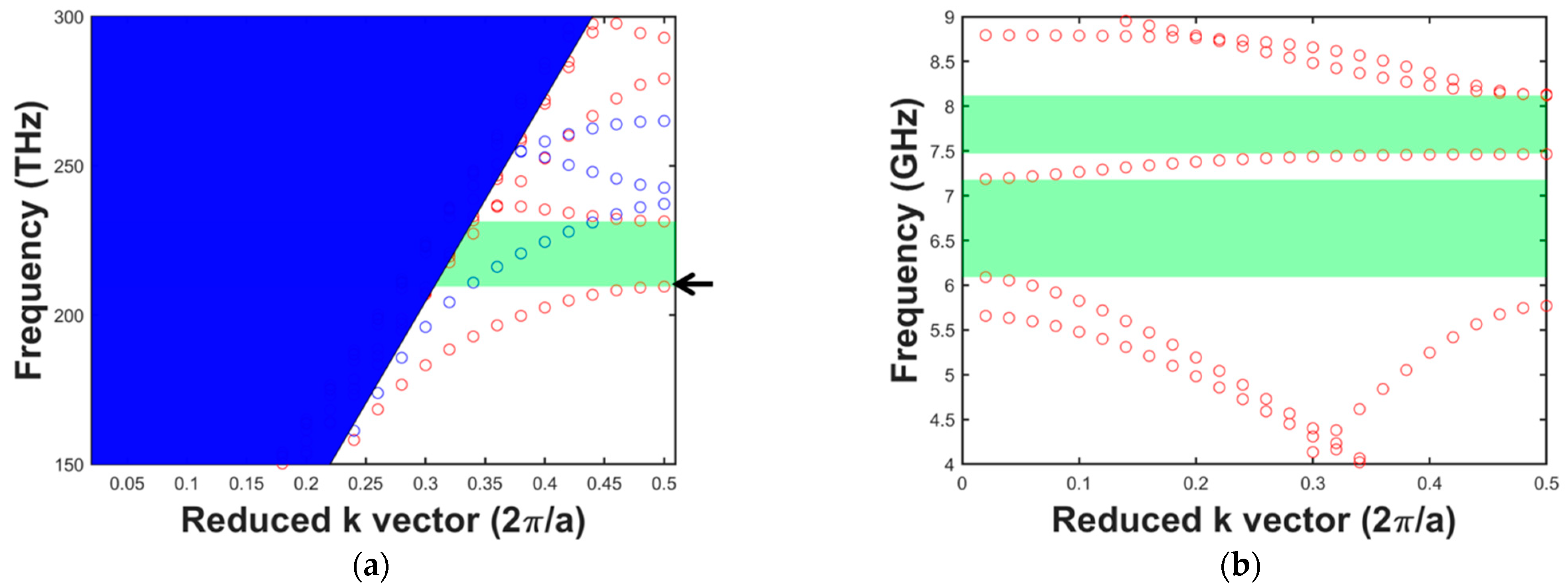
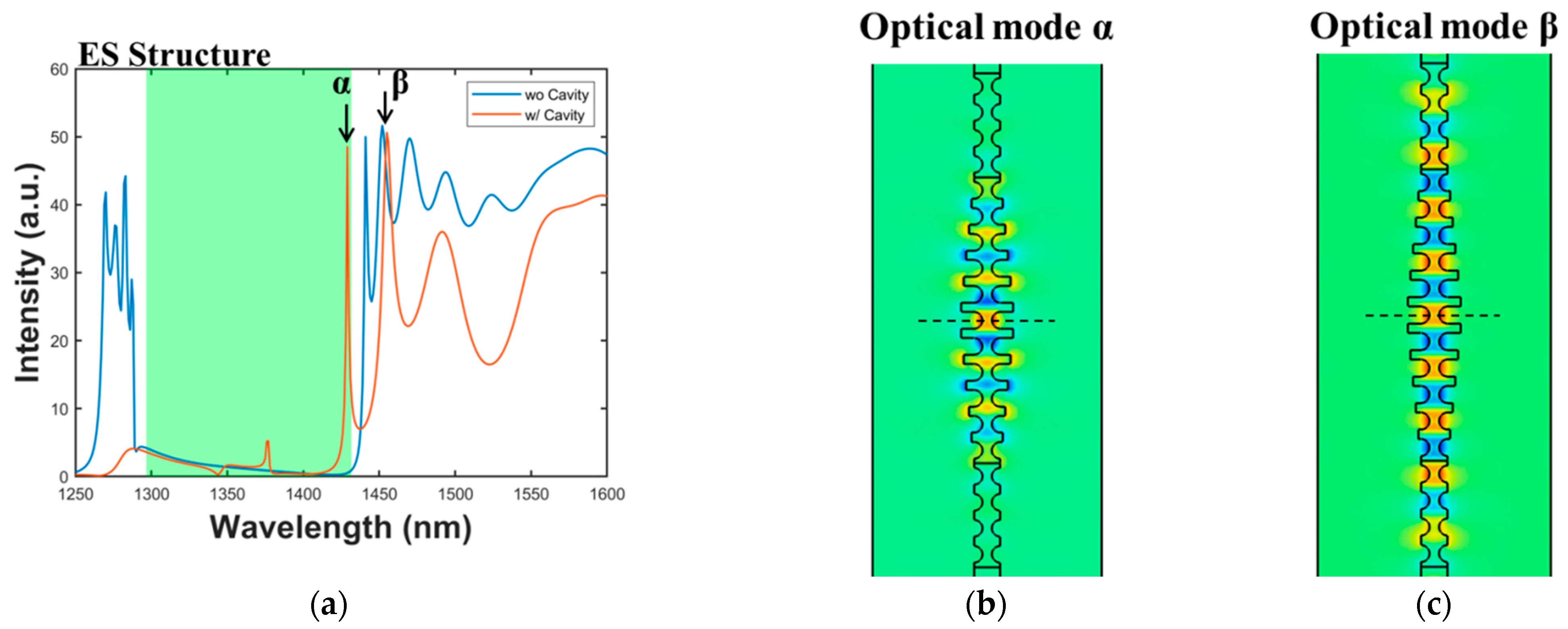
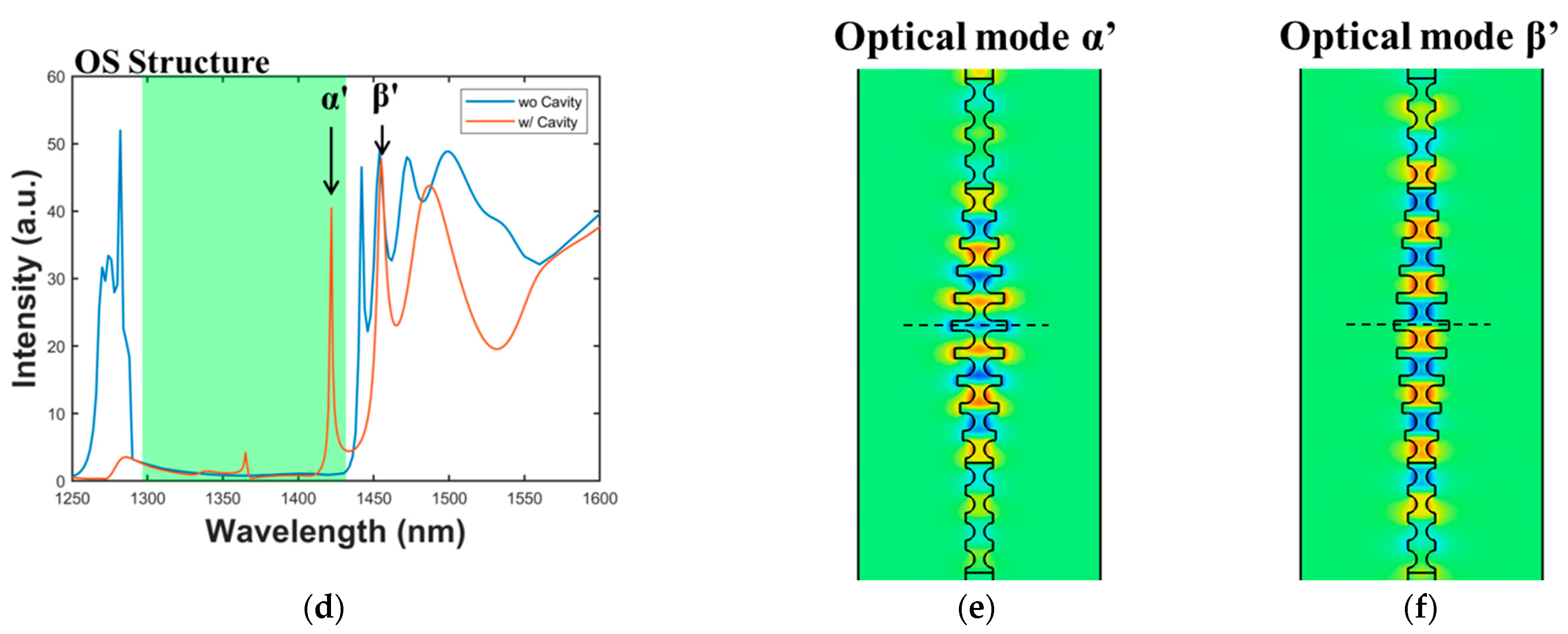

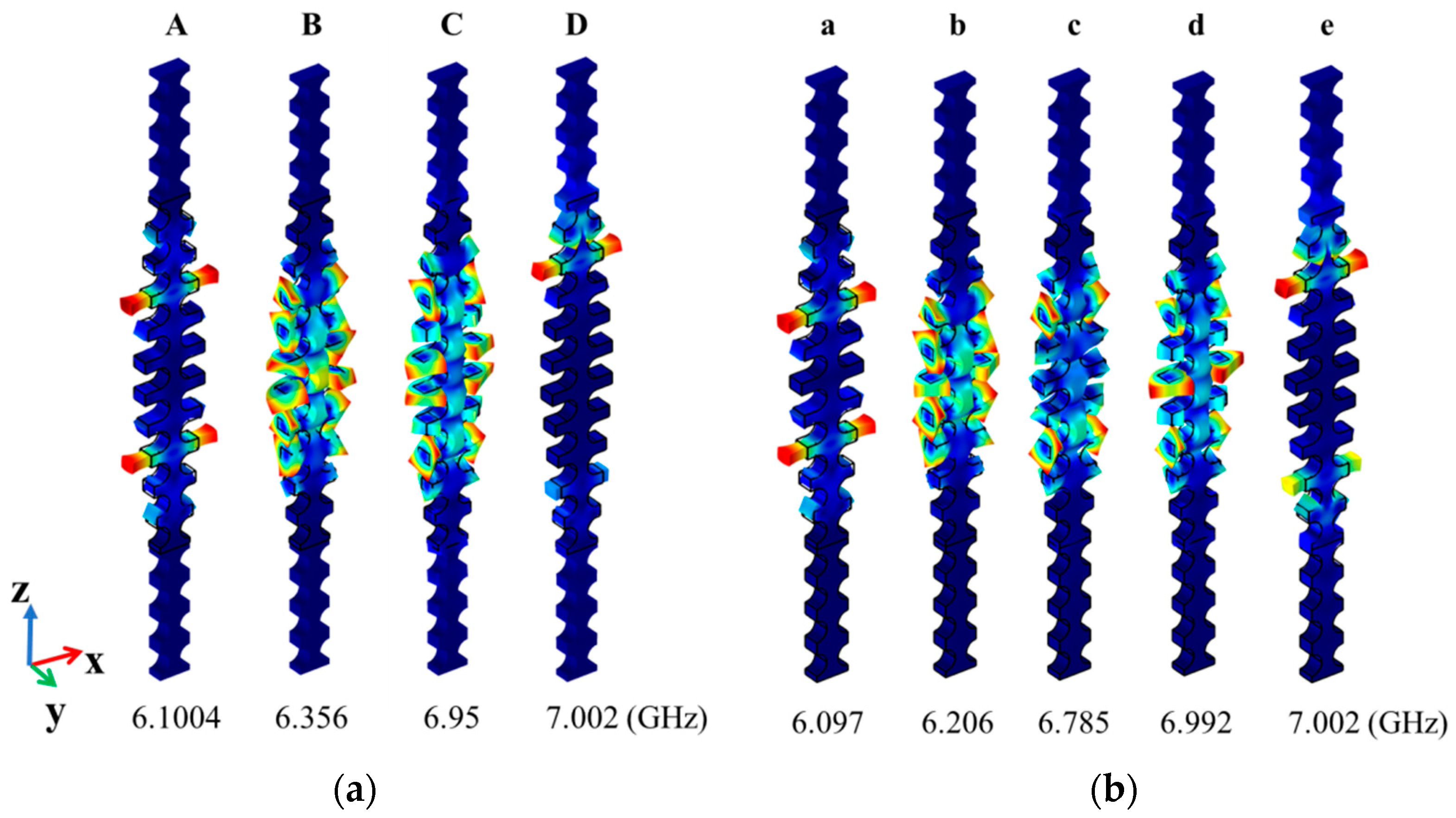

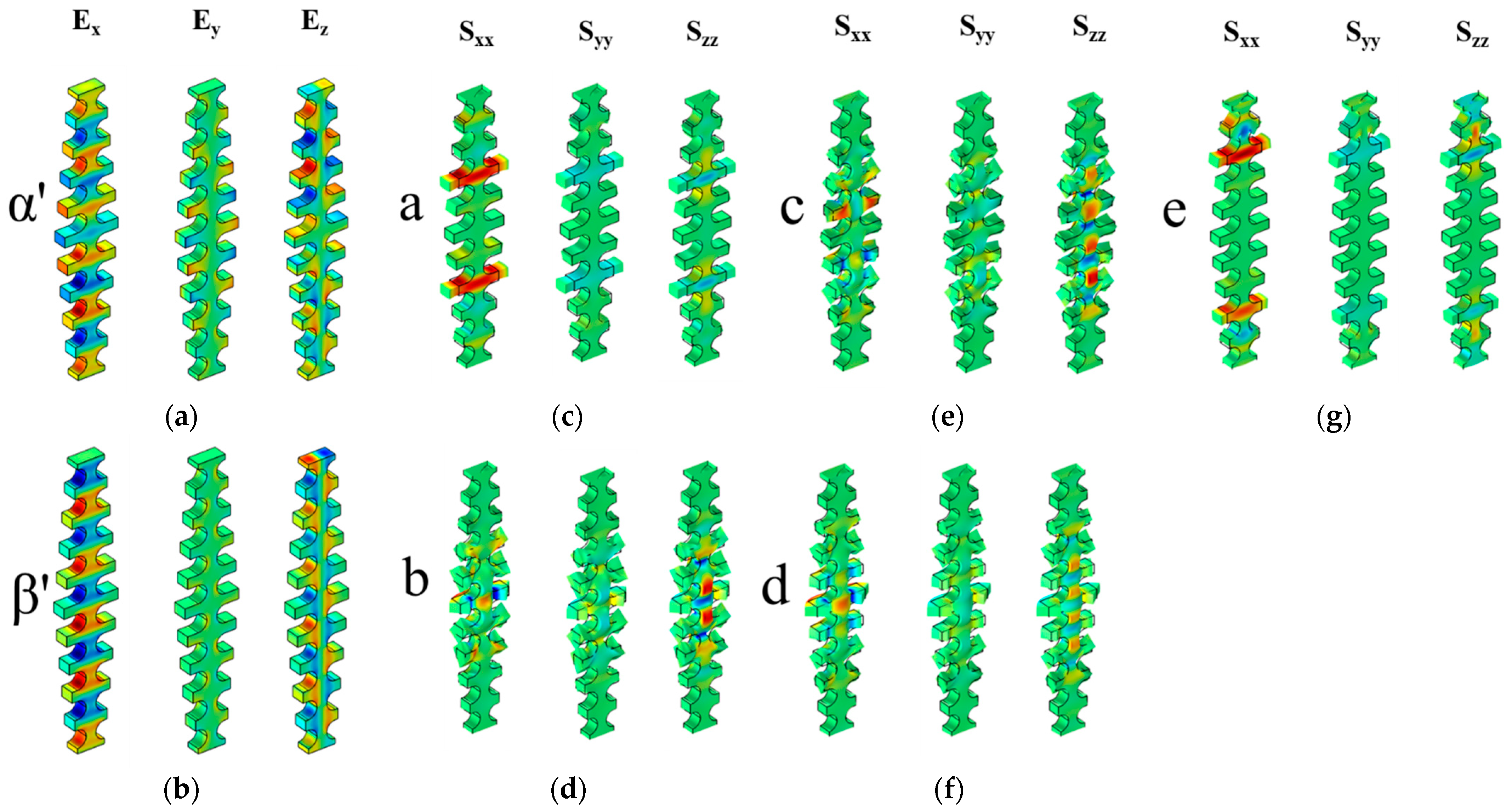
| Acoustic Modes | Optics Modes | ||
|---|---|---|---|
| α | β | ||
| A | gPE | −1.4923 | −1.1245 |
| gMB | −0.1540 | 0.2934 | |
| g | −1.6463 | −0.8311 | |
| B | gPE | −0.0104 | −0.0018 |
| gMB | −0.2095 | −0.0914 | |
| g | −0.2199 | −0.0932 | |
| C | gPE | −0.2274 | −0.184 |
| gMB | −0.1409 | −0.030 | |
| g | −0.3683 | −0.214 | |
| D | gPE | 0.9848 | 0.7641 |
| gMB | 0.0501 | 0.1958 | |
| g | 1.0349 | 0.9599 | |
| Acoustic Modes | Optics Modes | ||
|---|---|---|---|
| α’ | β’ | ||
| a | gPE | 1.7791 | 1.234 |
| gMB | 0.1429 | −0.297 | |
| g | 1.922 | 0.937 | |
| b | gPE | 0.0040 | −0.0017 |
| gMB | −0.2259 | −0.0603 | |
| g | −0.2219 | −0.0620 | |
| c | gPE | −0.0172 | −0.0746 |
| gMB | −0.2569 | −0.0222 | |
| g | −0.2741 | −0.0968 | |
| d | gPE | −0.2694 | −0.1995 |
| gMB | −0.1954 | −0.0868 | |
| g | −0.4648 | −0.2863 | |
| e | gPE | 1.5339 | 1.1256 |
| gMB | 0.1135 | 0.2892 | |
| g | 1.6474 | 1.4148 | |
Publisher’s Note: MDPI stays neutral with regard to jurisdictional claims in published maps and institutional affiliations. |
© 2022 by the authors. Licensee MDPI, Basel, Switzerland. This article is an open access article distributed under the terms and conditions of the Creative Commons Attribution (CC BY) license (https://creativecommons.org/licenses/by/4.0/).
Share and Cite
Hsiao, F.-L.; Tsai, Y.-P.; Chang, W.-S.; Chiu, C.-C.; Lin, B.-S.; Chiang, C.-T. Photo-Elastic Enhanced Optomechanic One Dimensional Phoxonic Fishbone Nanobeam. Crystals 2022, 12, 890. https://doi.org/10.3390/cryst12070890
Hsiao F-L, Tsai Y-P, Chang W-S, Chiu C-C, Lin B-S, Chiang C-T. Photo-Elastic Enhanced Optomechanic One Dimensional Phoxonic Fishbone Nanobeam. Crystals. 2022; 12(7):890. https://doi.org/10.3390/cryst12070890
Chicago/Turabian StyleHsiao, Fu-Li, Ying-Pin Tsai, Wei-Shan Chang, Chien-Chang Chiu, Bor-Shyh Lin, and Chi-Tsung Chiang. 2022. "Photo-Elastic Enhanced Optomechanic One Dimensional Phoxonic Fishbone Nanobeam" Crystals 12, no. 7: 890. https://doi.org/10.3390/cryst12070890
APA StyleHsiao, F.-L., Tsai, Y.-P., Chang, W.-S., Chiu, C.-C., Lin, B.-S., & Chiang, C.-T. (2022). Photo-Elastic Enhanced Optomechanic One Dimensional Phoxonic Fishbone Nanobeam. Crystals, 12(7), 890. https://doi.org/10.3390/cryst12070890







